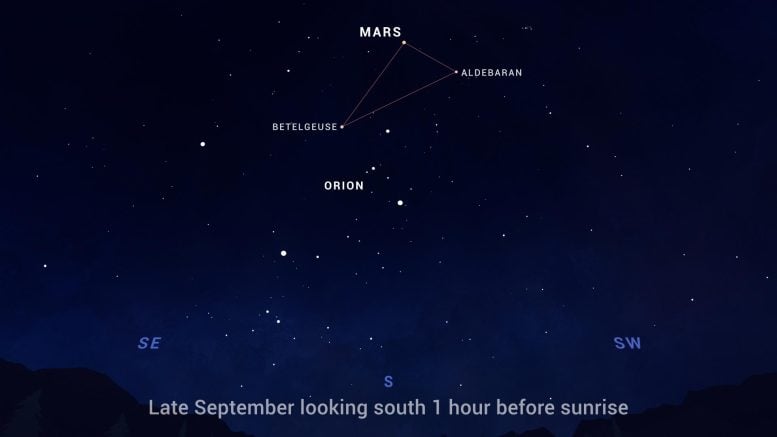What are some skywatching highlights in September 2022?
What’s Up for September 2022? Mars is on the move, prime viewing time for Jupiter, and a clever way to find your bearings on the equinox.
In September, you’ll find Mars hanging out high in the south on mornings before sunrise. Early in the month, it’s near orange-colored Aldebaran, the star that forms the eye of Taurus the bull. Over the course of the month, Mars will work its way eastward from Aldebaran toward reddish Betelgeuse, creating a sort of “red triangle” in the morning sky. Then the Red Planet will appear to hit the brakes and stop its eastward motion, to hang out in that triangle for the next month or so. (We’ll talk about what’s going on there in next month’s skywatching tips.)
Mars forms a triangle of reddish objects in September, and into October, as it hangs near bright red stars Aldebaran and Betelgeuse in the morning sky. Credit: NASA/JPL-Caltech
On the morning of September 11th, before sunrise, you’ll find the Moon just a couple of finger-widths from Jupiter in the sky. This will make for a great viewing opportunity to observe them together through binoculars. Jupiter’s at opposition this month, making it visible all night under clear skies. Plus, it’s around this time when the planet’s at its biggest and brightest for telescope viewing. However, a pair of good binoculars is enough to reveal the giant planet’s four large moons as little starlike points of light next to Jupiter.
Also, later this month on the 29th, Juno spacecraft is scheduled to make a special, fast flyby of one of those icy moons, Europa. The spacecraft is slated to pass a little over 200 miles (320 km) above the moon’s surface, returning images and science data.
In addition, NASA is currently preparing its Europa Clipper spacecraft for launch in 2024. To investigate whether Europa could have conditions suitable for life, it will make dozens of close flybys of the Jovian moon.
Turning to the evening sky, you’ll have Saturn together with Jupiter as your planetary companions all month long. On the night of September 9th, Jupiter and Saturn escort the Moon across the sky. You’ll see the trio rising in the southeast in the first couple of hours after dark, and gliding westward together over the course of the night. By the end of the month, you’ll observe the pair of planets rising even earlier, appearing in the east soon after it gets dark, with bright Jupiter hanging low in the sky.
On the night of September 9, see the nearly full Moon escorted across the sky by Jupiter and Saturn. Credit: NASA/JPL-Caltech
September 23rd brings the September equinox, which marks the official start of fall in the Northern Hemisphere, and the start of spring in the Southern Hemisphere. The equinoxes occur twice per year when Earth’s tilt with respect to the Sun is the same for both hemispheres. Both north and south receive the same amount of sunlight, and day and night are, briefly, of nearly equal length.
Illustration showing how Earth’s tilt leads to the Northern and Southern Hemispheres receiving changing amounts of sunlight over the course of the year. At the equinoxes, neither hemisphere is more tilted toward the Sun, so both hemispheres receive the same amount of sunlight. Credit: NASA/JPL-Caltech
And, get this: if you take note of exactly where the Sun appears to rise and set on the equinoxes, those points mark the locations of due east and due west, respectively.
That’s something quite useful to know for skywatchers, whatever hemisphere you happen to live in. So take note of any buildings, tall trees, lampposts, and the like at those places on the horizon. That way you can use them to find your bearings when looking skyward all year long.














